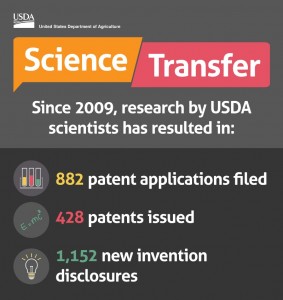What if I told you a scientist had recently discovered a way to remove up to 98% of the allergens in peanuts without affecting the flavor, thereby diminishing a severe health threat to some 2.8 million Americans who suffer from peanut allergies?
Or that a small family business is working on a project that could quench the thirst of billions of people around the world with technology that’s capable of taking water from any source and making it safe to drink?
If that sounds a little like science fiction to you, you wouldn’t be alone. But both examples exist today as part of the hundreds of scientific breakthroughs made by USDA and USDA-supported scientists since the start of the Obama Administration.
When people think of USDA, they may not immediately think of cutting-edge science or discovery. But USDA is the world’s largest agricultural research force. USDA employs around 3,000 scientists, economists, statisticians and others, and funds thousands more at land-grant universities and other institutions across the country. Together, their work has helped to shape the lives of billions of people around the world.
Under the Obama Administration, USDA has made a powerful statement about the importance of scientific discovery by strengthening our institutions, building our capacity and leveraging the strengths of our outside partners to do the same. From the farm to the lab to the boardroom, we’ve increased our investment in delivering problem-driven and solutions-based science that empowers farmers, foresters, ranchers, landowners, resource managers, professors and policymakers to help manage the risks we face.
Studies have shown that every dollar invested in agricultural research now returns over $20 to our economy. For our part, since 2009, USDA has invested $19 billion in research both intramural and extramural. As a result of that investment, research conducted by USDA scientists has resulted in 883 patent applications filed, 405 patents issued and 1,151 new inventions disclosures covering a wide range of topics and discoveries since 2009.
USDA also continues to aggressively partner with private companies, universities and others to transfer technology to the marketplace to benefit consumers and businesses alike. Over the years, USDA innovations have created all manner of products Americans use every day, from cosmetics, to insect controls, leathers, shampoos and of course food products. Here is a sample of USDA’s work:
- Frozen orange juice concentrate
- Turf used on many NFL and other sports fields across the country
- “Permanent press” cotton clothing
- Almost all breeds of blueberries and cranberries currently in production
- 80 percent of all varieties of citrus fruits grown in the U.S. and
- The mass production of penicillin during World War II
Still today, our scientists are pushing the boundaries of what’s possible and creating new miracles on behalf of the American people year after year. Their incredible dedication underscores the importance of government funding for research so that we can continue to make cutting-edge scientific breakthroughs with real potential for commercial application and growth. In recent years, some of their other discoveries include:
- A new process to turn old tires into zinc fertilizer
- A new kind of flour made from chardonnay grape seeds that can prevent increases in cholesterol and weight-gain
- A portable method for identifying harmful bacteria in food that prevents foodborne illness and safeguards public health
- A new soil nitrogen test that rapidly and inexpensively determines the total amount of nitrogen in the soil that is available to a plant. The use of this test reduces fertilizer application amounts, reduces costs for farmers, and benefits the environment
- A new process for pasteurizing shelled eggs that uses radio frequency energy that is 1.5 times faster than the current pasteurization process and that does not affect the eggs’ appearance. This fast new technology should increase the number of pasteurized eggs and reduce the threat of illness from uncooked and undercooked shelled eggs
And there are many more where that came from.




